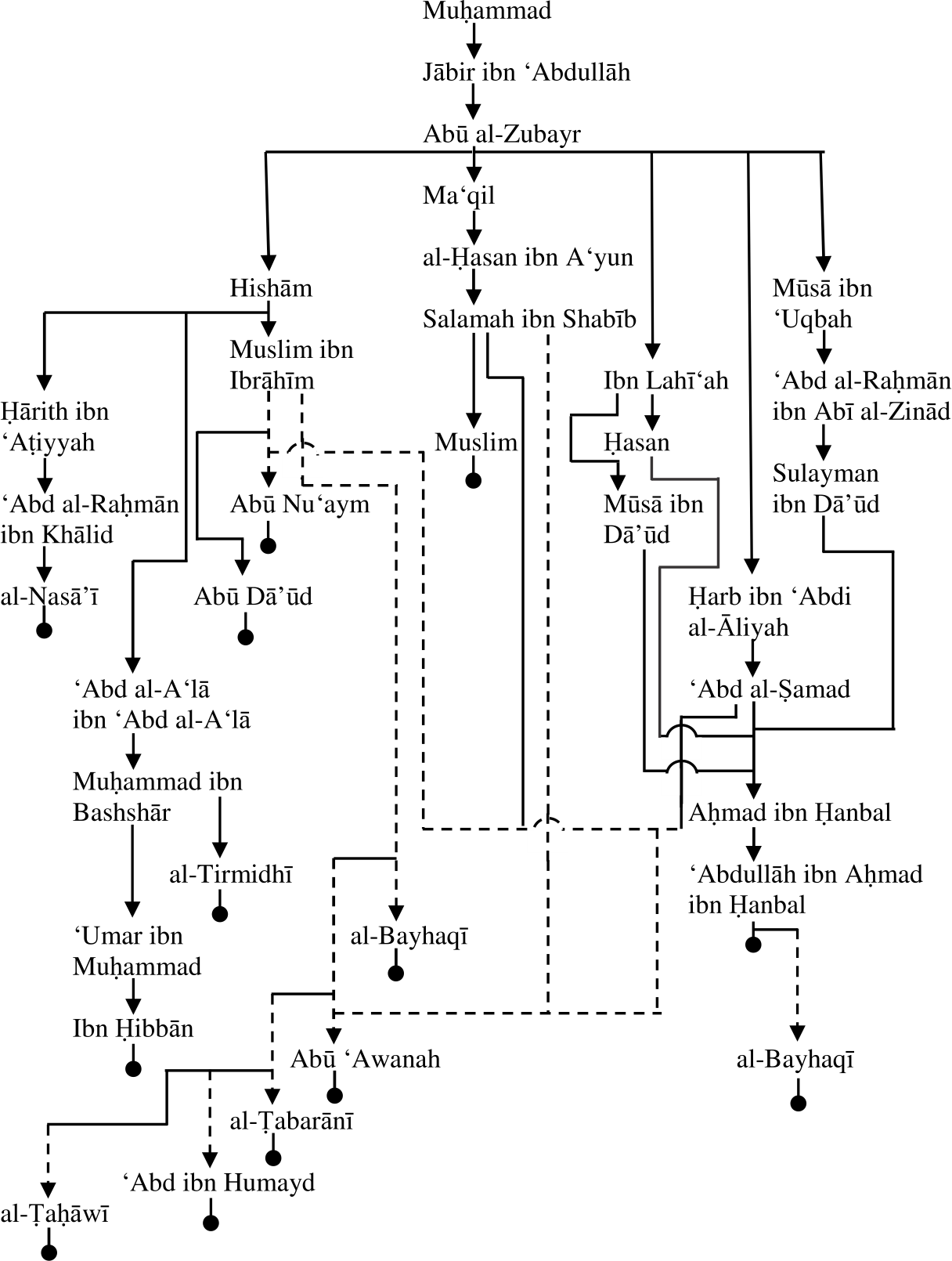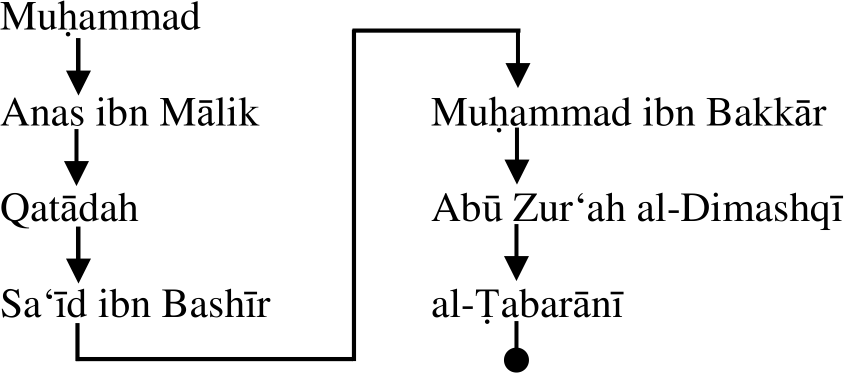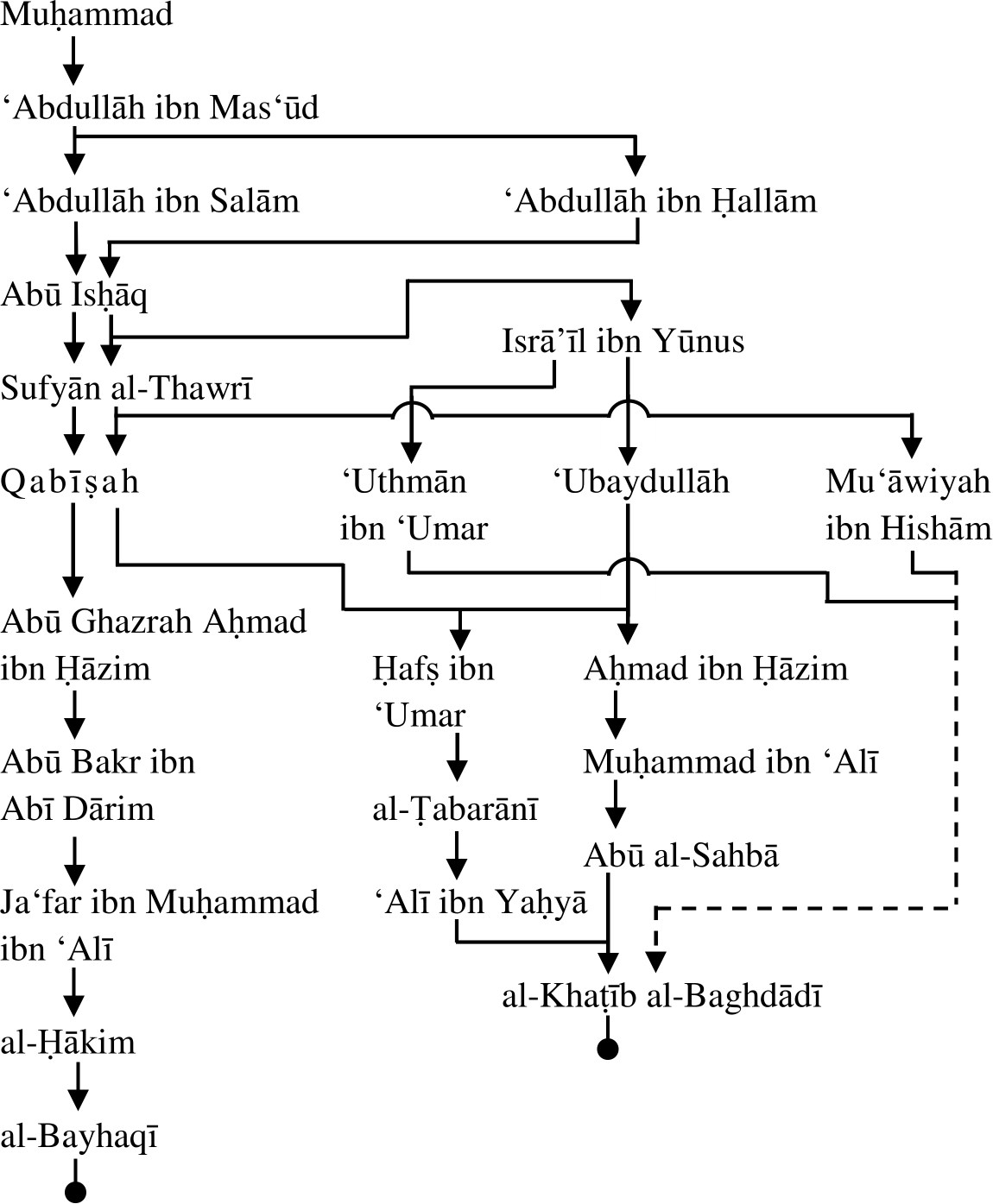1. Jabir ibn
‘Abdullah (rta)
وحدثني سَلَمَةُ بن شَبِيبٍ حدثنا الْحَسَنُ بن اَعْيَنَ حدثنا مَعْقِلٌ عن ابي
الزُّبَيْرِ قال قال جَابِرٌ سمعت النبي صلى اللّٰه عليه وسلم يقول إذا أحدكم
اَعْجَبَتْهُ الْمَرْاَةُ فَوَقَعَتْ في قَلْبِهِ فَلْيَعْمِدْ الى امْرَاَتِهِ
فَلْيُوَاقِعْهَا فإن ذلك يَرُدُّ ما في نَفْسِهِ
Jabir
stated: “I heard the Prophet (sws) say: ‘When anyone of you likes a woman and
she finds a place in his heart, he should come to his wife and satisfy his
sexual urge with her, because this will turn that woman away from his heart.”
Following is
the schematic illustration of the isnad of this narrative’s variants:

Though Abu al-Zubayr Muhammad ibn Muslim ibn Tadrus al-Makki
(d. 116 AH) is regarded as trustworthy by many authorities, here is the jarh
recorded on him by al-Mizzi:
In the opinion of Nu‘aym ibn Hammad, Ayyub al-Sakhtiyani regards him to be weak
and in the opinion of Ahmad ibn Hanbal, Sufyan ibn ‘Uyaynah regards him to be
weak. Ibn Abi Hatim’s opinion about him is: yuktabu hadithuhu wa la yuhtajju
bihi. Abu ‘Adi says that though he is reliable yet he has reported some
narratives from du‘afa’.
Shu‘bah has regarded Abu al-Zubayr to be da‘if as well.
Abu al-Zubayr is also a mudallis
and all his variants have his ‘an‘anah except one recorded by Ahmad ibn Hanbal.
However, in this narrative, the weakness is because of ‘Abdullah ibn Lahi‘ah.
Following is the jarh on ‘Abdullah ibn Lahi‘ah recorded by
al-Dhahabi (d. 748 AH):
Yahya ibn Ma‘in says that he is da‘ifun la yuhtajju bihi; Yahya ibn Sa‘id would
regard him to be nothing (kana la yarahu shay’an); al-Nasa’i says that he is
da‘if; Abu Zur‘ah and Abu Hatim say: amruhu mudtaribun yuktabuhu li al-i‘tibar;
al-Juzjani says that there is no light in his narratives and it is not
appropriate to adduce from him.
Ibn Hajar has recorded him among the mudallisin and referred
to the fact that Ibn Hibban has said that he does tadlis from al-du‘afa’.
It may be noted that in all the narratives in which ‘Abdullah ibn Lahi‘ah
appears, there exists his ‘an‘anah.
2. Anas ibn Malik (rta)
حدثنا أبو زرعة الدمشقي ثنا محمد بن بكار
ثنا سعيد بن بشير عن قتادة عن أنس أن رسول الله صلى الله عليه وسلم نظر إلى امرأة
فأعجبته فأتى زوجته زينب بنت جحش فقضى حاجته ثم خرج فقال إذا نظر الرجل إلى امرأة
فليأت أهله فليقض حاجته فقال رجل فإن لم تكن له امرأة قال فلينظر إلى السماء
Anas ibn Malik
reported that God’s Messenger (sws) looked at a woman and was attracted to her.
Thereupon he came over to his wife Zaynab bint Jahash and satisfied his desire
from her. Then he came out and said: “If a person looks at a woman, he should
come to his wife and satisfy his desire from her.” A person asked: “What if a
person does not have a wife?” He replied: Then he should look toward the sky.”
Following is
the schematic illustration of the isnad of this narrative’s variants:

Qatadah ibn Di‘amah is a mudallis
this narrative has his ‘an‘anah.
According to al-Nasa’i, he is da‘if;
Ibn Hibban
records that he has a very bad memory and makes a lot of errors and reports from
Qatadah narratives which do not have any corroboration. Al-‘Uqayli
records that according to Yahya ibn Ma‘in, he is laysa bi shay’.
3. ‘Abdullah ibn Mas‘ud (rta)
أخبرنا أبو عبد الله الحافظ أنا جعفر بن
محمد بن علي الصائغ بالكوفة ثنا سعا أبي بكر بن أبي دارم ثنا أحمد بن حازم بن أبي
غرزة ثنا قبيصة ثنا سفيان عن أبي إسحاق عن عبد الله بن سلام عن عبد الله بن مسعود
قال رأى رسول الله صلى الله عليه وسلم امرأة فأعجبته فأتى سودة وهي تصنع طيبا
وعندها نسوة فأخلينه فقضى حاجته ثم قال أيما رجل رأى امرأة فأعجبته فليأت أهله فإن
معها مثل الذي معها
‘Abdullah ibn Mas‘ud stated: “God’s Messenger (sws) saw a
woman. Thereupon, he came to Sawdah and she had worn a perfume and there were
other women alongside her. He told them to grant him privacy and he fulfilled
his desire from her. Then he said: ‘Any person who sees a woman who attracts her
should come to his wife because she has what she has.’”
Following is
the schematic illustration of the isnad of this narrative’s variants:

About ‘Abdullah ibn Hallam, al-Dhahabi says la yakadu yu‘raf.
Abu Ishaq al-Sabi‘i who is a known mudallis
and all variants contain his ‘an‘anah.
Abu Bakr ibn
Abi Darim is a liar.
Al-Khatib has specified that al-Fadl ibn Sukayn, ‘Abd al-Rahman
ibn al-Mahdi, Yahya ibn Sa‘id al-Qattan and Muhammad ibn Kathir al-‘Abdi have
reported this narrative from Sufyan from Abu Ishaq from ‘Abdullah ibn Hallam
from ‘Abdullah ibn Mas‘ud as mawquf on the latter.
___________
|